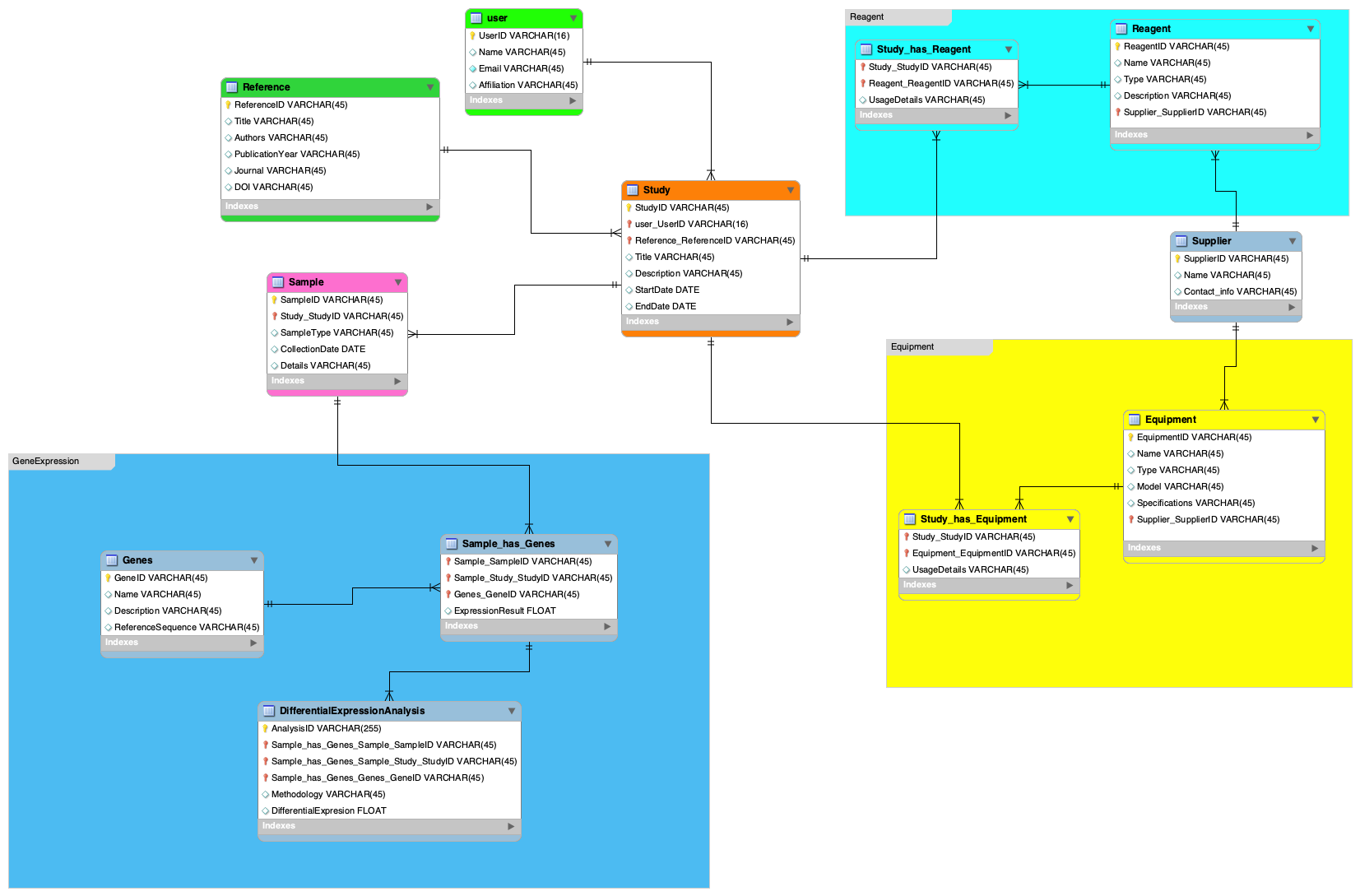
This data modelis structured to manage the complexities of RNA-seq analysis studies:
- User Entity:
- Primary Key: UserID
- Attributes: Name, Email, Affiliation
- This entity detail the personal and professional information of the researchers conducting the RNA-seq analyses.
- Reference Entity:
- Primary Key: ReferenceID
- Attributes: Title, Authors, PublicationYear, Journal, DOI
- This entity serves as a repository of literature references that are used to support the studies.
- Study Entity:
- Primary Key: StudyID
- Foreign Keys: UserID (linking to the User entity), ReferenceID (linking to the reference entity)
- Attributes: Title, Description, Start Date, End Date
- This entity acts as the central repository for individual RNA-seq studies.
- Sample Entity:
- Primary Key: SampleID
- Foreign Key: StudyID (linking to the Study entity)
- Attributes: SampleType, CollectionDate, Details
- This entity contains information about the biological samples used in RNA-seq studies.
- Genes Entity:
- Primary Key: GeneID
- Attributes: Name, Description, ReferenceSequence
- This entity catalogs genes analyzed in RNA-seq studies.
- Sample_has_Genes Entity:
- Foreign Key:: SampleID (linking to the Sample entity), GeneID (linking to the Gene entity), StudyID (linking to the Study entity)
- Attributes: ExpressionResult
- This entity represents the many-to-many relationship between Samples and Genes.
- DifferentialExpressionAnalysis Entity:
- Primary Key: AnalysisID
- Foreign Keys: SSampleID (linking to the Sample entity), GeneID (linking to the Gene entity), StudyID (linking to the Study entity)
- This entity stores the outcome of differential expression analyses.
- Reagent Entity:
- Primary Key: ReagentID
- Foreign Key: SupplierID
- Attributes: Name, Type, Description,
- This entity catalogs reagents used in RNA-seq studies.
- Equipment Entity:
- Primary Key: EquipmentID
- Foreign Key: SupplierID
- Attributes: Name, Type, Model, Specification
- This entity catalogs equipement used in RNA-seq studies.
- Supplier Entity:
- Primary Key: SupplierID
- Attributes: Name, ContactInfo
- This entity catalogs suppliers for reagents and equipment used in RNA-seq studies.
The data model is designed to capture the intricate details and interdependencies of RNA-seq studies. It allows for comprehensive tracking of each element involved in the research, from the personnel and literature references to the detailed specifics of the samples, genes, and the equipment and reagents used, culminating in the analysis of gene expression.
The relationships among entities are crucial for maintaining data integrity and ensuring accurate queries. For example:
- User-Study Relationship
- Each study is associated with a single user (researcher), but a user can conduct multiple studies.
- Study-Reference Relationship
- A study cis associated with a single reference but a reference can contain multiple studies.
- Study-Sample Relationship
- Each sample is linked to a specific study. A study can have multiple samples but a sample belongs to only one study, forming a one-to-many relationship between Study and Sample.
- Sample-Genes Relationship
- The Sample_has_Genes entity acts as an associative table to manage the many-to-many relationship between Samples and Genes, allowing for the association of multiple genes with multiple samples. This table stores the result of the expression of each gene in the sample.
- Reagent and Equipment-Supplier Relationship
- Each reagent and piece of equipment is provided by a supplier. Since a supplier can provide multiple reagents or pieces of equipment, there is a one-to-many relationship between Supplier and both Reagent and Equipment entities.
- Study-Reagent/Equipment Relationship
- Both reagents and equipment are used in various studies. A study may use multiple reagents and pieces of equipment, and the same reagent or equipment can be used across different studies. This is represented as a many-to-many relationship, which would typically involve a join table for each pair to track the usage.
- DifferentialExpressionAnalysis Relationship
- The DifferentialExpressionAnalysis entity is connected to Sample, Genes, and Study. Different pairs of genes can be compared in a Differential Expression Analysis.
In summary, the data model is a relational schema that captures all aspects of RNA-seq analysis within a research framework. It's structured to ensure that all the components of the studies are interlinked, providing a robust foundation for data retrieval, analysis, and integrity.